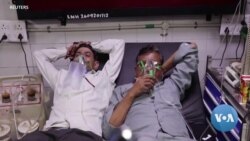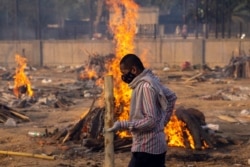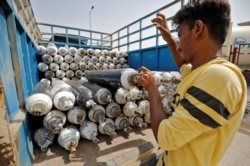Hospitals in India are running desperately short of beds, medical oxygen and key drugs for coronavirus treatment as a lethal second wave of the pandemic brings the country’s health care system to a breaking point.
India reported 314,835 new COVID-19 infections Thursday, the highest one-day total posted by any nation during the year-long global pandemic.
The public health emergency in India is on a scale doctors have never seen before. “It is worse than a tsunami, worse than carpet bombing,” says Jalil Parkar, senior pulmonary consultant at Lilavati Hospital in Mumbai, India’s financial capital that boasts of some of the country’s best hospitals and medical infrastructure.
In locked-down cities, the wail of ambulance sirens is the only sound that breaks the silence on streets and the only crowds seen are outside hospitals and crematoriums as families scramble to get beds or cremate loved ones.
“The influx of patients is so much that we have to treat patients on the wheelchair, sometimes in the ambulance itself and we are doing our best,” according to Parkar.
As oxygen ran scarce, the Delhi High Court ordered the federal government to divert oxygen from industries to hospitals. “You can’t have people die because there is no oxygen," a two-judge bench said late on Wednesday. "Beg, borrow or steal, it is a national emergency.”
The order came after one of the city’s leading private sector hospital chains, Max Healthcare, told the court that most of its hospitals were working on “dangerously low levels of oxygen supply.”
Prime Minister Narendra Modi has called India’s second wave a “storm.”
“The corona crisis has led to a huge demand for oxygen throughout the country,” Modi said in a nationwide address Tuesday night. “We are taking steps to address this very quickly.” He said authorities were working with states and private firms to deliver oxygen with speed.
It will be too late for many already mourning dead relatives.
As the virus ravaged Delhi, doctors said they were flooded with endless calls from desperate people seeking help for beds and oxygen.
“My phone kept ringing all night. People said my son is dying, mother-in-law is dying, or another relative is suffering, so I am troubling you. I had the same request from all – their oxygen level is falling, where should they go?” said Arvind Kumar, a chest surgeon at Medanta Hospital in Gurugram, an affluent business district near New Delhi.
“I don’t think even nightmare is a correct word which expresses the gravity of the situation. There is not a single hospital bed in Delhi today,” Kumar said.
The northern Haryana state ordered police to escort vehicles carrying oxygen cylinders after authorities said one tanker was looted. Local television showed people crowding with empty oxygen cylinders around refilling facilities in the most populous state of Uttar Pradesh. Social media has become a helpline filled with pleas for getting beds or oxygen.
India’s health minister, Harsh Vardhan, said that to address the exponential spike in demand, the government has increased the quota of oxygen for the seven worst-hit states in the country.
Daily infections have risen at a staggering pace in the past seven days, making it India’s deadliest week since the pandemic.
The swift rise has taken aback a country where a steadily downward graph of infections from last September to February brought hope the virus was in retreat – in early February it was counting just around 10,000 cases a day. The optimism was short lived as the case count began rising and then exploded this month.
Prime Minister Modi’s government been criticized for allowing super spreader events in recent weeks, such as a massive Hindu religious festival and packed political rallies led by top leaders. The gatherings took place without COVID-19 protocols, as tens of thousands jostled close to each other mostly without masks. As many as 2.8 million pilgrims took a dip in the Ganges River in Haridwar city on April 12.
Experts say more infectious variants of the coronavirus also could be driving the relentless rise in cases. One such variant called the “double mutant” was first found in the western state of Maharashtra in February, but it failed to ring alarm bells.
“It’s known that this variant is more transmissible, moves more easily between people and is able to evade the immune response in some cases,” says Gautam Menon, Physics and Biology Professor at Ashoka University. “We should have been more careful. Certainly, we should step up genomic sequencing that is needed to detect variants.”
The second wave, which has made India the epicenter of the global pandemic, is not expected to peak soon, according to Menon.
“The situation is worrying. We are already at around 300,000 cases, and at 2,000 odd deaths daily. Our vaccination program is faltering a little bit. All this suggests the next couple of weeks is not going to be good for India,” says Menon.
That will be a challenge for an exhausted health care system.
“I think we have nearly crumbled and crashed, I should say. I don’t know how we are going to resurrect,” says pulmonary consultant Parkar, even as he says he is fervently hoping for a dip in the second wave. “Let us all vaccinate everybody, let us save lives. Let there be more beds, let there be more oxygen.”
That is also what people are demanding as they question why authorities did not prepare adequately for a second wave.












